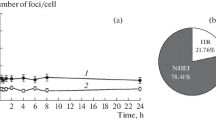Summary
Effects of metabolic inhibitors on the rejoining of broken single strands of DNA of mouse L cells induced by X-irradiation were studied by the sucrose gradient sedimentation method. Inhibitors of protein and DNA syntheses, such as cycloheximide and 5-fluorodeoxyuridine, could not suppress the rejoining of broken strands, when they were introduced into cultures at the time of irradiation. However, 2.5-hour pretreatment of cells with 5-fluorodeoxyuridine was capable of reducing the rate of rejoining. In addition, proflavin, one of DNA-binding substances tested, prevented the rejoining. These results suggest that pre-existing DNA-related enzymes, for instance, DNA polymerase and ligase, are responsible for the process.
Similar content being viewed by others
References
Gittelson, B. L., Walker, I. O.: Interaction of proflavin with DNA and deoxyribonucleohiston. Biochim. biophys. Acta (Amst.)138, 619–620 (1967).
Grigg, G. W.: Induction of DNA breakdown and death inEscherichia coli by phleomycin. Molec. Gen. Genetics104, 1–11 (1969).
Ham, R. G.: An improved nutrient solution for diploid Chinese hamster and human cell lines. Exp. Cell Res.29, 515–526 (1963).
Humphrey, R. M., Steward, D. L., Sedita, B. A.: DNA strand breaks and rejoining following exposure of synchronized Chinese hamster cells to ionizing radiation. Mutation Res.6, 459–465 (1968).
Humphrey, R. M., Steward, D. L., Sedita, B. A.: Report in the 23rd Annual Symposium in M. D. Anderson Hospital and Tumor Institute (1969) (in press).
Hurwitz, J., Furth, J. J., Malamy, M., Alexander, M.: The role of deoxyribonucleic acid in ribonucleic acid synthesis, III. The inhibition of the enzymatic synthesis of ribonucleic acid and deoxyribonucleic acid by actinomycin D and proflavin. Proc. nat. Acad. Sci. (Wash.)48, 1222–1230 (1962).
Kajiwara, K., Kim, U. H., Mueller, G. C.: Phleomycin, an inhibitor of replication of HeLa cells. Cancer Res.26, 233–236 (1966).
Kaplan, H. S.: DNA-strand scission and loss of viability after X-irradiation of normal and sensitized bacterial cells. Proc. nat. Acad. Sci. (Wash.)55, 1442–1446 (1966).
Kapp, D. S., Smith, K. C.: Lack ofin vitro repair of X-ray-induced chain breaks in DNA by the polynucleotide-joining enzyme. Int. J. Radiat. Biol.14, 567–571 (1969).
Lerman, L. S.: Structural considerations in the interaction of DNA and acridines. J. molec. Biol.3, 18–30 (1961).
Lett, J. T., Caldwell, L., Dean, C. J., Alexander, P.: Rejoining of X-ray induced breaks in the DNA of leukemic cells. Nature (Lond.)214, 790–792 (1967).
Littlefield, J. W.: DNA synthesis in partially synchronized L cells. Exp. Cell Res.26, 318–326 (1962).
Lohman, P. H. M.: Induction and rejoining of breaks in the deoxyribonucleic acid of human cells irradiated at various phases of the cell cycle. Mutation Res.6, 449–458 (1968).
Matsudaira, H., Nakagawa, C., Hishizawa, T.: Rejoining of X-ray-induced breaks in the DNA of Ehrlich ascites tumor cellsin vivo. Int. J. Radiat. Biol.15, 95–100 (1969).
McGrath, R. A., Williams, R. W.: Reconstructionin vivo of irradiatedEscherichia coli deoxyribonucleic acid; the rejoining of broken pieces. Nature (Lond.)212, 534–535 (1966).
Painter, R. B., Cleaver, J. E.: Repair replication, unscheduled DNA synthesis, and the repair of mammalian DNA. Radiat. Res.37, 451–466 (1969).
Reich, E., Franklin, R. M., Shatkin, A. J., Tatum, E. L.: Action of actinomycin D on animal cells and viruses. Proc. nat. Acad. Sci. (Wash.)48, 1238–1245 (1962).
Sawada, S., Okada, S.: Rejoining of single strand breaks of DNA in cultured mammalian cells. Radiat. Res.41, 145–162 (1970).
Studier, F. W.: Sedimentation studies of the size and shape of DNA. J. molec. Biol.11, 373–390 (1965).
Tanaka, N., Yamaguchi, H., Umezawa, H.: Mechanism of action of phleomycin, a tumorinhibitory antibiotic. Biochem. biophys. Res. Commun.10, 171–174 (1963).
Terasima, T., Fujiwara, Y., Tanaka, S., Yasukawa, M.: Synchronous culture of L cells and initiation of DNA synthesis. In: Cancer cells in culture (H. Katsuta, ed.), p. 73–84. Philadelphia: University Park Press 1968.
—, Tsuboi, A.: Mammalian cell DNA isolated with minimal shearing, a sensitive system for detecting strand breaks by radiation. Biochim. biophys. Acta (Amst.)174, 309–314 (1969).
——, Yasukawa, M.: Isolation of long-pieces of DNA from cultured mammalian cells, breaks by radiation and its rejoining. Japan. J. Genetics44 (Suppl. 2), 2–3 (1969).
Author information
Authors and Affiliations
Additional information
Communicated by J. Tomizawa
Rights and permissions
About this article
Cite this article
Tsuboi, A., Terasima, T. Rejoining of single breaks of DNA induced by X-rays in mammalian cells: Effects of metabolic inhibitors. Molec. Gen. Genet. 108, 117–128 (1970). https://doi.org/10.1007/BF02430518
Received:
Issue Date:
DOI: https://doi.org/10.1007/BF02430518




